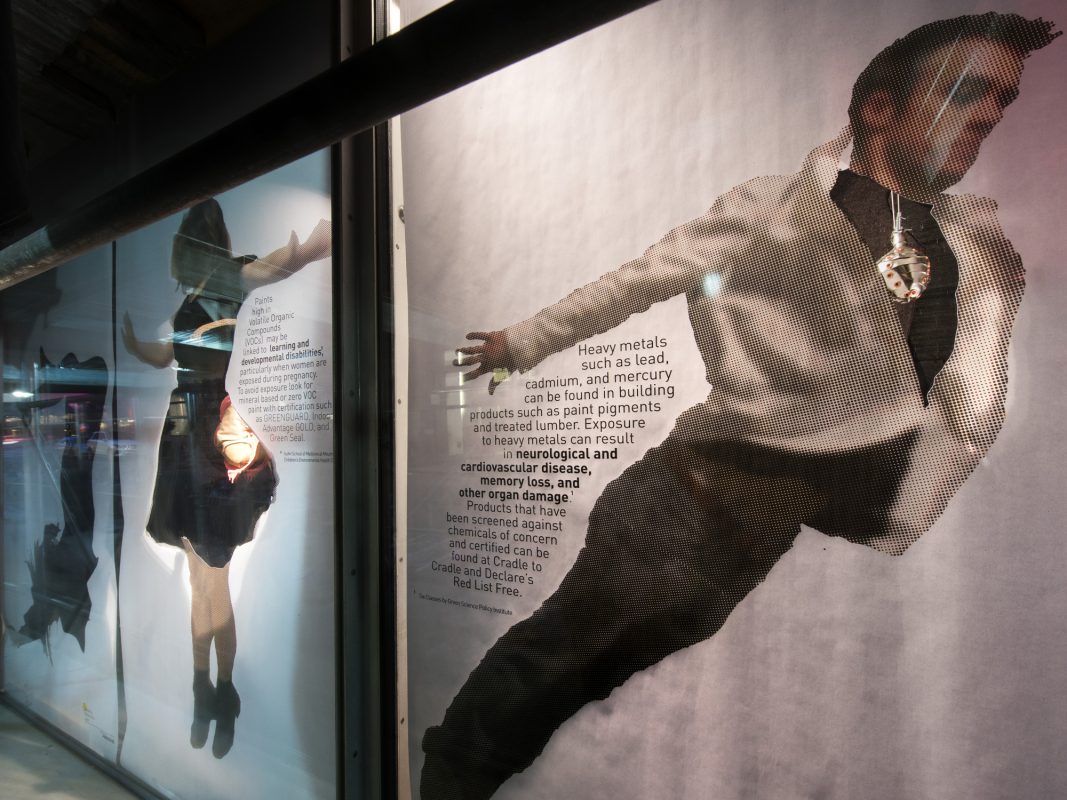Imagine a toxic chemical—some weird, translucent, neon substance, glowing like Nickelodeon slime or the bad guy from Scooby Doo. Now imagine that it’s real. It’s been proven highly poisonous and it’s in someone’s outstretched hand. They’re offering it to you. You probably wouldn’t accept it—no thanks. You certainly wouldn’t eat it. You likely wouldn’t feel safe standing next to it. You wouldn’t feel comfortable with it in your home or your office, or really anywhere near you or anyone you care about. And yet most of us tolerate toxics like this literally every day: many substances that we would for sure not allow inside our bodies are integral to the built environments we spend nearly all our time inside.
This is the sort of overwhelming “aha!” moment that comes to mind while moving through Material Bodies, the Healthy Materials Lab’s Winter 2016/2017 installation in the Kellen Gallery at Parsons School of Design. Dramatic prints of human bodies frame blocky organs constructed from raw building materials. Associated text excerpts relate the diptych images to an overall narrative of human health and changing construction practices

Example: A 6-foot tall image of a man in a white blazer, unbuttoned at the top to reveal a shimmering stainless steel heart made from scrap sheet metal, hex nuts, lag bolts, and salvaged copper wire and rivets. His arms are outstretched as though in free fall, mid-leap off a high dive board. Lines of text curl off his torso, he’s dodging them: “Exposure to heavy metals can result in neurological and cardiovascular disease, memory loss, and other organ damage.”
It’s a simple enough message, but one that’s hard to really remember never mind live by: How do we police the health hazards of the places we put ourselves?
Founded in 2015, The Healthy Materials Lab at Parsons School of Design is a collective of design researchers who bring a consideration of human health to all aspects of design and building practices. The key word here is all—all material choices have been considered carefully on all building projects—and this committed praxis is very much on display at Kellen.







The guy in the white blazer, along with the other exuberant bodies in the exhibit, dance around—or try to escape from—the more academic tone of the written warnings they share wall-space with. A helpful note at the end of the reading, down near the man’s pant legs, instructs viewers to consult Cradle to Cradle or the Declare Red List for more information on healthy material alternatives—a truly welcome recommendation after reading that “heavy metals such as lead, cadmium, and mercury can be found in building products such as paint pigments and treated lumber.” You have to wonder about the walls of the very gallery space you’re standing in, and remember the last time (last week) you sat tranquilly on a treated-wood garden patio or deck, thinking it was just a peaceful, safe place to be.
But the show is not meant to scare audiences so much as raise awareness of a burgeoning design field—healthy materials—and, more generally, the lockstep relationship between building materials and human health. The art also inspires a kind of optimism about how and what consumers can do to make decisions that are actually healthy. A trip to Whole Foods in a Prius doesn’t exactly cut it in 2017, when, according to another diptych in the exhibition, recent studies have linked popular clothing textiles with kidney cancer, thyroid disruption, elevated total cholesterol, and obesity.





Other organs offer similar information, and anyone interested might want to take notes: A set of boxy wooden lungs informs viewers to “look for wood products labeled No Added Formaldehyde (NAF), Ultra-Low Emission Formaldehyde (ULEF), or No Added Urea Formaldehyde (NAUF)”—to avoid Urea-Formaldehyde, a chemical with linkages to cancer, asthma, and respiratory diseases. A brain is made of recycled denim insulation and PureBond Plywood, a healthier alternative to popular composite wood products like particle board and MDF. The form of a fetus, cut from a reused paint can and finished with RomaBio mineral paint, warns that “Paints high in Volatile Organic Compounds (VOCs) may be linked to learning and developmental disabilities, particularly if women are exposed during pregnancy.”
It’s the vulnerability of the human body that’s showcased here. The catalogued maladies—all too common to most people—clash with humanity itself, as depicted in a woman’s frame and an anatomically abbreviated version of her intestines, constructed from banded sheer wool fabric. Something truly delicate in her appearance contrasts with words like “cancer” and “disruption.” But there’s something else on display, too: a resilience and hope. Humans, as demonstrated by each of the Healthy Materials Lab’s projects and this show in particular, are smart, innovative, and adaptable. Much like nature, and the built environments in which we live, we’re constantly able to change.

Read More
Join Our Academic Network
Get Access to our carefully researched and curated academic resources, including model syllabi and webinars. An email from an academic institution or a .edu email address is required. If your academic institution does not use .edu email addresses but you would like to join the network, please contact healthymaterialslab@newschool.edu.
Already have an account? Log in